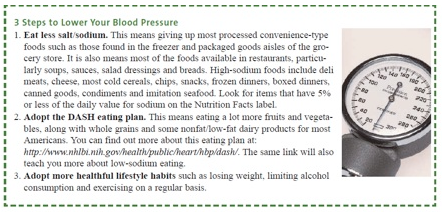Hypertension: Drugs Not the Cure
 High blood pressure, or hypertension (HTN), is the most commonly diagnosed form of cardiovascular disease (CVD). More than half of all Americans have developed HTN before they qualify for Medicare.
High blood pressure, or hypertension (HTN), is the most commonly diagnosed form of cardiovascular disease (CVD). More than half of all Americans have developed HTN before they qualify for Medicare.Ten years later another 70% of those fortunate enough to make it to their 65th birthday without developing HTN will be diagnosed with HTN. By age 85, more than 90% of all Americans will have developed HTN.1 The risk of dying from CVD (i.e., heart attacks, strokes and heart failure) has been shown to double for each 20 mmHg rise in systolic blood pressure (SBP) and/or 10 mmHg rise in the diastolic blood pressure (DBP) starting at healthy BP of about 110/70 mmHg. The increased risk of CVD with higher SBP and/or DBP was shown to be for people between ages 40 and 90. By the time someone’s BP hits 140/90 (the minimum for a diagnosis of HTN) the risk of dying from CVD has already increased at least three- to fourfold. Most physicians prescribe drugs such as diuretics, beta blockers, calcium-channel blockers and ACE-inhibitors or ARBs to lower high BP. While these drugs do usually lower BP, there is real concern about their adverse side effects such as a dry, hacking cough; increased blood sugar levels; adverse changes in blood lipids; nausea; electrolyte imbalances; dizziness; heart arrythmias; impotence and many others. Do the Benefits of BP Drugs Outweigh Their Harm? Back in the 1980s a very large study of men found that a more aggressive treatment of HTN with drugs actually increased the risk of dying of a heart attack. The December 15, 2004, issue of the Journal of the American Medical Association carried an article showing that taking one class of anti-HTN drugs (calcium-channel blockers) actually doubled the risk of dying from CVD in older women compared with cheaper diuretics. Dr. Wassertheil-Smoller’s study showed that diuretics were more effective than ACE inhibitors and beta blockers at lowering BP. However, thanks largely to drug company promotional efforts to get MDs to prescribe their newer and more profitable drugs, the use of diuretics is falling, and those of more expensive – and in many cases less effective – drugs is increasing. Are Diuretics the Best Treatment for HTN? The January 2005 issue of the American Journal of Cardiology carried an article showing that people given diuretics to lower their BP had nearly a 15% reduction in their risk of dying from CVD. Even so this same studied showed that the diuretics had a lot of adverse effects. The most troubling was about a 40% increased risk of developing type 2 diabetes. Beta blockers also promote weight gain and increase the risk of developing type 2 diabetes. This study was widely reported as proof that taking drugs to treat HTN was medically justified because the overall benefits outweighed the risks. However, keep in mind that HTN increases the risk of dying from CVD by at least 300%. A treatment that can reduce the risk of dying from CVD only by less than 15% has hardly solved the problem. It appears that someone who takes the safest and most effective drugs to lower their high BP is still going to be at least 2-3 times as likely to die from CVD as someone whose BP is 110/70 mmHg or less. Bottom Line A diet low in salt and high in fruits, vegetables, whole grains, nonfat dairy and modest amounts of seafood and lean meats has been shown to reduce BP more than any drug. Such a diet can also lower serum cholesterol and other CVD risk factors and reverse atherosclerosis and insulin resistance. Such a diet does not promote diabetes and has been shown to lower blood sugar levels to normal while patients are taken off their diabetes medications. It would appear that a healthful diet and exercise program is far more effective for reducing BP and preventing CVD and type 2 diabetes than most doctors believe. It is certainly preferable to treat HTN with diet and exercise than to use drugs that may promote diabetes, have many other adverse side effects and do little to reduce the risk of dying from CVD. By James J. Kenney, PhD, RD/LN, FACN. References: 1. JAMA 2002;287:1004
